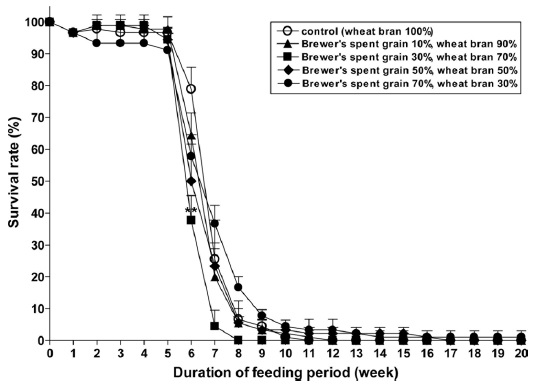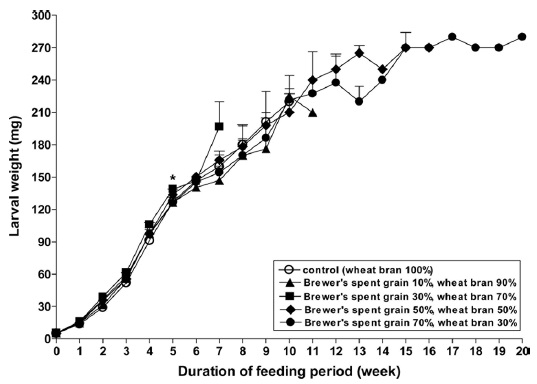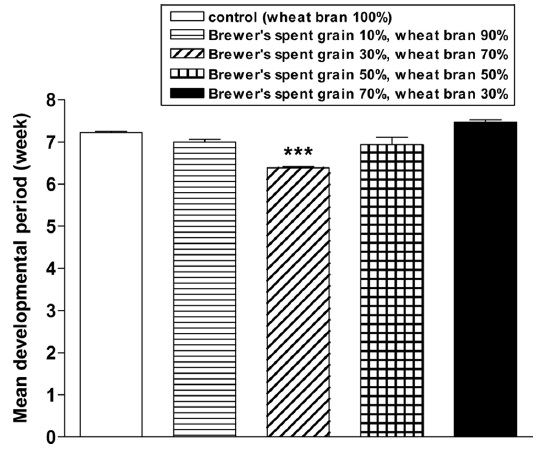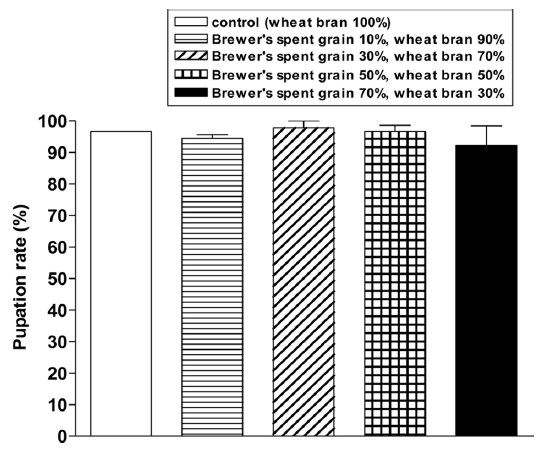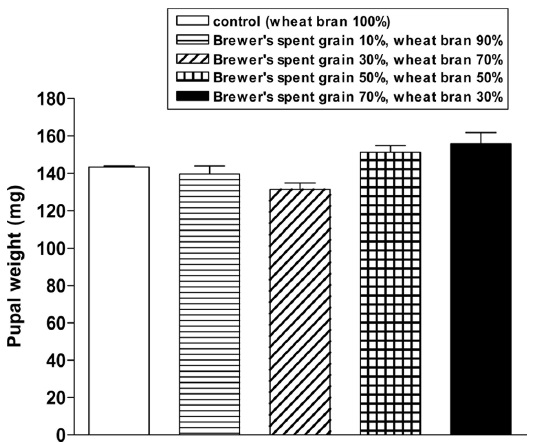



Mealworms, Tenebrio molitor (Coleoptera: Tenebrionidae), are widely used as food sourcefor animal rearing as well as human diet. Conventionally, mealworms raised on wheat bran. In this study, we investigated the effects of brewer’s spent grain (BSG) on the growth of mealworm larvae to reduce the rearing cost. We prepared five different diets with various BSG content, 0, 10, 30, 50, and 70% of heated air dried BSG with wheat bran. We compared survivorship, larval weight, developmental duration, pupation rate, and pupal weight of five different groups of T. molitor raised on these five diets. The larval survivorships were almost similar with the control group except a group with 70% of BSG. For the larval weight, groups with 30% and 50% of BSG gained more weight than that with control treatment, 0% of BSG. For the developmental period, the groups with 30% of BSG took less time compared to the control group. In all treatment groups, more than 90% of pupation rate were observed. Especially, the group with 30% of BSG showed highest pupation rate among the five groups. Wheat bran with 30~50% of BSG was the optimal diet for successive insect rearing among the five diet treatments. Based on this study, we concluded that adding BSG to wheat bran helps to improve the quality of T. molitor and to reduce the rearing period.
Insects are a promising candidate for animal feed ingredients because it can be efficiently utilized as good nutrients by livestock. Insects convert vegetable proteins that obtained from their food into animal protein inside of their body before accumulating nutrients. This process is 4 ~ 9 times efficient compared to other livestock. Insects including mealworms, black soldier flies, grasshoppers and crickets are identified as a promising candidate for an essential protein ingredient for animal feed because they are rich in essential amino acids (Choi
Rearing mealworms is more environmental friendly because of low feed cost (He
The brewing industry generates relatively large amounts of by-products and wastes; spent grain, spent hops and yeast being the most common. However, they can be readily recycled and reused because they are also organic matter. The brewing industry tends to be more environmental friendly as consumers prefer environmental friendly products (Ishiwaki
The standard mass-rearing techniques for mealworms are required as insect farming industry is rapidly growing as well as it is about to be industrialized. In this study, we investigated the effects of BSG on larval growth of mealworms such as larval survivorship, larval weight, larval period, pupation rate, pupal weight. Based on this study, we can conclude that BSG will be used as a promising alternative mealworm food source mixed with wheat bran.
All life stages of
>
Feed with Different Contents of brewer’s spent grain (BSG)
Larvae of
>
Larval Growth of T. molitor with Different Diets
Seventh or eighth larvae that were 60 d after hatching were tested their growth rate with different diet. For each group, 30 larvae were tested in a plastic container (10 x 4 cm (diameter x height)) with three biological replications. All the larvae were fed wheat bran with different contents of BSG. We put 5 grams of cabbage leaves as a water source twice per week. As a control diet, we used wheat bran without any BSG based on the standard rearing condition. Each group of larvae fed on different contents of BSG was compared its survivorship, average larval weight, duration for each development stage, pupation rate, and pupal weight.
The larval survivorship of each group maintained on wheat bran with different contents of BSG was compared to the control group that were maintain on 100% of wheat bran. The survivorship was checked until pupation. Therefore, the control group had been checked for 10 wk, the 10% BSG group for 11 wk, the 30% BSG group for 7 wk, the 50% BSG group for 16 wk, and the 70% BSG group for 20 wk.
We checked the survivorship for the first 4 wk because insect producers conventionally selling
The maximum weight gain rate was calculated by the percentage of the weight gain for each experimental groups compared to the maximum larval weight of control group (Table 1). When compared average larval weights with different diet groups to that of the control group, the group with 30% BSG was the highest from first week to seventh week except the fourth week. Especially, the maximum weight gain rate for the 30% BSG was the highest at the second week as 40%. It was not checked after 7 wk when pupation was observed. The group with 50% BSG showed the highest maximum weight gain rate at fourth, eighth, and ninth weeks. Especially, this group showed 20% higher than that of the control group. However, the groups with 10% and 70% BSG showed low weight gain rate especially the group with 10% of BSG showed no weight gain after fifth week. The group with 70% brewers group showed low weight gain rate after third week as well as no weight gain at seventh and ninth weeks.
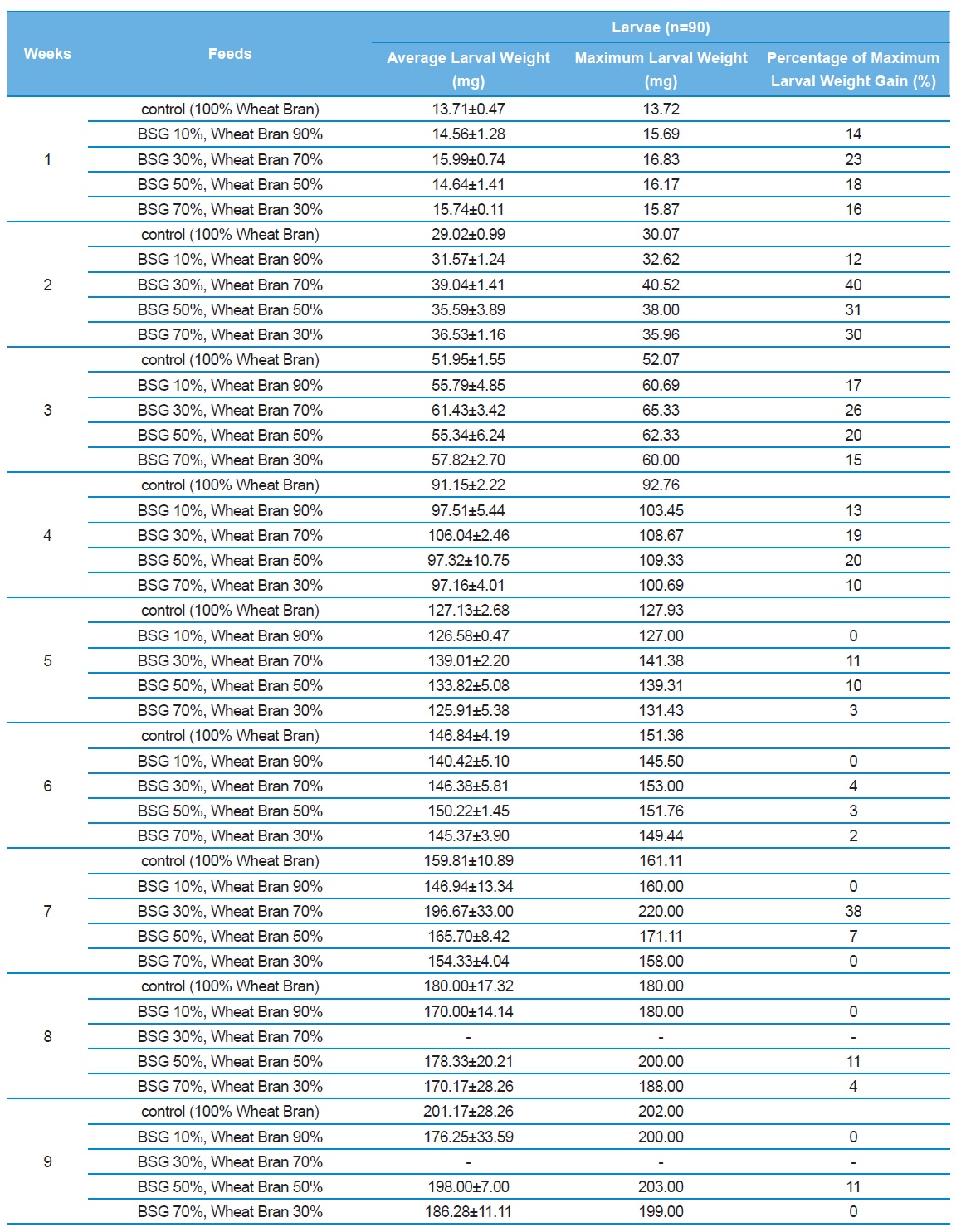
Larval weight changes with different contents of Brewer's Spent Grain (BSG) as a feed supplement.
The duration for pupation from seventh or eighth instar larvae ca. 60 d after hatching was measured by checking the status of

Averages of larval duration, pupal weight, and pupation rate with different contents of Brewer's Spent Grain (BSG) as a feed supplement.
The pupation rates for each group were more than 90%, so it was not significantly different for all the groups except that for 30% BSG with the highest pupation rate (Fig. 4, Table 2).
There was no significant difference for pupal weight between the control group and the group with 10% BSG. However, the group with 30% BSG showed less pupal weight and that with 50% BSG showed more pupal weight compared to the control group (Table 2). In addition, the pupal weight was compared by time (Table 3). At the sixth week, the group with 50% BSG showed 32% heavier pupal weight than that of the control group. However, all the groups showed less than 10% heavier pupal weight than that of the control group at the seventh week. The group with 30% BSG showed 32% heavier than the control group at the eighth week. At the ninth week, the group with 50% BSG showed 14% and that with 70% BSG showed 13% heavier than the control group. However, the groups with 10% and 30% BSG were not check any more after the ninth week.
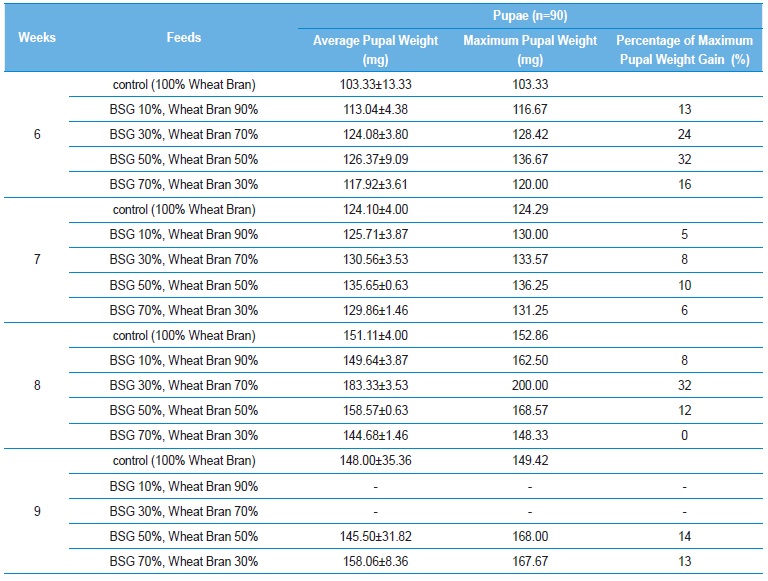
Pupal weight gain with different contents of Brewer's Spent Grain (BSG) as a feed supplement.
Mealworms are generally maintained on rice bran, wheat bran, bean flour, and peanut flour as a food source and various vegetable leaves and fruit skins as a nutritional supplement (Kim
Wheat bran with 30% and 50% of BSG maximized the larval survivorship, but that with 70% of BSG showed the lowest larval survivorship when compared to the control group. Wheat bran with 30% BSG showed the highest larval weight gain from the first to seventh week except the fourth week when compared the larval weight increase for the first 9 wk. During the eighth to ninth weeks, wheat bran with 50% of BSG made the highest larval weight gain. However, wheat bran with 10% and 70% of BSG showed relatively low larval weight gain. The larval duration for wheat bran with 30% of BSG was significantly shorter than that for other diets. The pupation rates were more than 90% for all groups. The pupal weight was not different between the wheat bran with 10% of BSG and the control feed. However, wheat bran with 30% was lighter than control group, and those with 50% and 70% were heavier. Wheat bran with 30% showed less pupal weight because of shorter larval period.
BSG has been used as a feed supplement (Szponar
BSG have been used various human foods including breads and snack to increase fiber content because it is a by-product for human diets. BSG contains a large amount of dietary fibers, so it has diverse advantages to prevent diseases including cancer, gastrointestinal disorders, diabetes and heart disease (Stojceska
BSG has positive effects on larval growth of mealworm because it is an agricultural by-product with lots of potential with high nutrition contents for feed formulations. In this study, we confirmed that wheat bran with 30% and 50% BSG had good potential as a feed supplement for rearing mealworms. In Korea, mealworms have been used as feed for various pets. Therefore, the farmers rearing mealworms in mass-rearing facilities have been growing. To improve this industry, we need to find better quality food sources and to develop automated mass-rearing system. In this study, we confirmed the potential of BSG as a feed supplement to improve the quality of mealworm with low cost. Therefore, we expected that this study will help insect farmers to increase benefit as well as improve insect production industry.

